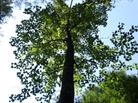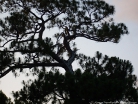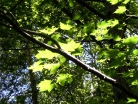for native species to inhabit. In addition, their fruit is poisonous to livestock, making the lives of ranchers more difficult in one of the top beef producing states in the USA.
And so began my research and quest to find native tree species that are strong, attractive and would be just as wonderful to have at your home or business as a non-native tree. I looked and looked through website nurseries, as well as brick and mortar nurseries, and found time and time again that the pretty flowering trees being offered were mostly non-natives. Thankfully both the Chinese Tallow and the Brazilian Peppertree are on the Federal list of noxious weeds and are therefore illegal to propagate or sell, but I rarely came across anyone giving particular attention or praise to some of our most beautiful natives. The more I researched, the more species I found I had never heard of. The Carolina Silverbell, the dozens of magnolias, the beautiful madrone, the flowering paloverdes... tree after tree with stunning attributes were found. Perhaps if there was a site like this one available for people to find these native tree species, they would be less inclined to use non-natives and in doing so, minimize the chances of more species escaping into the wild.
The most disturbing result of bringing non-native trees into the country, and what finally gave birth to action, was the discovery of what happened to the American Chestnut. I had sung Christmas songs my whole life, which crooned of roasting chestnuts on the fire, and yet I had never eaten one. As a child and young adult, I had thought perhaps it was a tradition of old, assuming people just really didn't eat them anymore. Occasionally I would find Chinese Chestnuts in the grocery store and would think, 'Oh! So they are still around to buy,' but I didn't know any better. It turns out the chestnuts of song were those of the mighty American Chestnut, which at one time made up approximately 25% of the entire Appalachian forest belt from northern Georgia all the way north into New England along the mountain range. Their population was estimated to be an astonishing 4 billion trees. That all changed due to Chinese chestnut trees being imported in 1904. Within decades, our trees were decimated by an imported tag-along known as the chestnut blight, and now they have been nearly wiped out. All that remain are diseased resprouted trees and a isolated healthy stand somewhere in the great lakes area. These trees are so precious the state governments are not releasing details of their whereabouts. There are efforts to breed disease resistant varieties to reintroduce into the wild, but they are hybrids of the American and Chinese Chestnut species. Our pure American Chestnut may be gone forever in much of its native range.
If that weren't bad enough, I discovered other imported problems. In 1900, another pest arrived- the Balsam woolly adelgid. It attacks Balsam Fir trees and has destroyed approximately 95% of the Balsam Firs in the Great Smokey Mountains, leaving 'ghost forests' of dead trees behind. The magical forests in the Pacific Northwest are also being impacted, as the Balsam woolly adelgid also preys upon Silver Fir, Grand Fir and Subapline Fir, which make up almost any image you can recall of the majesty of that landscape. Yet another heavy blow to the eastern forests of North America is the Hemlock woolly adelgid, which was accidentally imported from Asia in 1924. In less than 100 years, it has managed to damage an estimated 50% of all Eastern Hemlock trees throughout the range and is causing wide spread mortality to this beautiful native species.
As a child, I spent much of my time outside riding bicycles, playing in the community swimming pool, and exploring the woods with friends near my home. As an adult, I sought refuge from everything stressful on meandering trails and in the quiet of our great forests. I never realized how diverse, how important and how threatened they were. How could our forests, something so much larger than life, ever go away? How much of this did you know? I had no idea. Now that I do know, I want to help spread awareness of these issues, promote the use of native species by bringing our wonderful native trees into the light, and help preserve our forests that so often helped to preserve me. Thank you for taking the time to read my message and I hope you enjoy our site.
-Rebecca Weller



™
About Us
Want to add your tree to our picture gallery? Click here for details!
-Color denotes a tree that is rare or endangered


A message from the creator-
This website started out as a sole endeavor to bring together a collection of information to help educate others about my passion for native trees. (I have since dragged family and friends all over creation snapping pictures of trees, having them proof read articles, and spending hours upon hours in arboretums and parks. They are wonderfully supportive! Thank you in particular to Jake, Mom and Kandy!!) While living in Florida, I found I was in the heart of an invasion in both the animal and the plant worlds. Trees from across the globe were brought in for landscaping purposes and the warm, wet, sunny environment was an ideal place for these species to thrive. So much so, many escaped into the wild and started to have negative consequences on the native flora. Chinese Tallow (Triadica Loureiro) is one such species, as is the Brazilian Peppertree (Schinus terebinthifolius) and everywhere I looked, these trees were taking over. They are on roadsides, undeveloped property, in the woods, invading pastures, even popping up along fence lines and highways. You can see them spreading everywhere and can't imagine a way to contain it. Chinese Tallow is of particular concern as its leaf litter chemically alters the ground making it more difficult







Tree lists:
•A-Z by scientific
name
•A-Z by common
name
•By Family
For state A-Z list click state name below.



















